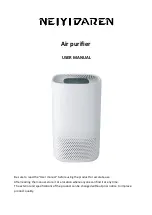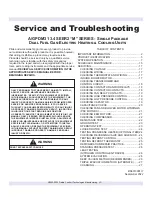
43
SERVICING
Refer to the cooling and heater performance charts in this
section for capacity test procedure.
A step-by-step procedure for determining source of trouble,
suggested method and normal values are provided in the
Diagnosis Charts.
Service operations requiring opening of the hermetically
sealed refrigeration system should not be performed in the
home. The unit must be taken to a well equipped shop
where special equipment for evacuating, dehydrating, charg-
ing and testing is available. The following equipment is
necessary.
Equipment to use dry nitrogen of no more than .0012 grains
of moisture. Vacuum pump capable of evacuating to a mini-
mum of 50 microns.
Vacuum Pump - Kenney or equivalent. Micron gauge to check
vacuum. Refrigerant charging cylinder accurate to within
1/4 oz. Electronic leak detector - General Electric or equiva-
lent. Electrical equipment to test: compressors, capacitors,
voltage relays and overload protectors Electrical test board
or portable equipment, including: volt meter, ammeter, and
watt meter. Silver soldering and brazing equipment: Pinch
off tools 1/4" to 5/8" Thermocouple tester.
Dehydrating And Evacuating Refrigeration System
A rather popular misconception exists that since air condi-
tioners normally operate with a refrigerant temperature
above 32°F., moisture in the system is harmless. Nothing
could be further from the truth. Oxygen from moisture plus
normal compressor and motor heat reacts chemically with
the refrigerant and oil to form corrosive hydrochloric and
hydrofluoric acids. These acids contribute to the break-
down of motor winding insulation and the corrosion of com-
pressor working parts and cause unnecessary compressor
failure. Sludge, which is a residue of the chemical action,
coats all compressor parts, the inside of refrigerant tubing,
and may even restrict refrigerant flow through the capillary
tube(s).
Leak Testing
Refrigerant leaks are best detected with a halide or elec-
tronic leak detector.
NOTE:
Leak detectors must be compatible with R-410A re-
frigerant.
The importance of careful leak testing cannot be overem-
phasized. Undetected leaks invariably lead to repeated calls
and eventually result in system contamination, restrictions
and burned out compressors.
For a system that contains a refrigerant charge and is sus-
pected of having a leak, stop the operation, check all tub-
ing and fittings. Soap suds may also be used.
NOTE:
The flame of the halide detector will glow green in
the presence of R-410A refrigerant.
If a leak is detected, do not attempt to apply more brazing
material to the joint. Recover the charge, unbraze the joint,
clean and rebraze.
For a system that has been newly repaired and does not
contain a charge, connect a cylinder of refrigerant, through
a gauge manifold, to the process tube of the compressor
and liquid line strainer. Open the valve on the cylinder and
manifold and allow the pressure to build up within the sys-
tem. Check for and handle leaks as described above.
After the test has been completed, recover the test charge,
evacuate the system, and recharge with clean refrigerant.
Brazing
Satisfactory results require cleanliness, experience and the
use of proper material and equipment.
The connections to be brazed must be properly sized, free
of rough edges and clean.
The generally accepted materials are:
SIL-FOS
(Alloy of 15% silver, 80% copper, 5% phosphorus) is
used without flux on copper to copper.
DO NOT USE FOR A
COPPER TO STEEL CONNECTION.
Recommended heat is
approximately 1400°F.
SILVER SOLDER
(Alloy of 30% silver, 38% copper, 32% zinc.)
is used with fluoride base flux on copper to steel, brass to
copper, steel to steel, brass to steel. Recommended heat
is approximately 1200°F.
Evacuation
WARNING
TO PREVENT SEVERE BURNS. DO NOT ALLOW THE
SLUDGE OR OIL TO CONTACT THE SKIN.
IMPORTANT NOTE:
Effective July 1,1992. Before opening
any refrigerant system it is the responsibility of the service
technician to capture the refrigerant for safe disposal.
This is the most important part of the entire service proce-
dure. The life and efficiency of the equipment is depen-
dent upon the thoroughness exercised by the serviceman
when evacuating air (non-condensables) and moisture from
the system.
Air in the system causes high condensing temperature and
pressure, resulting in increased power input and reduced
performance.
Moisture chemically reacts with the refrigerant and oil to
form corrosive hydrofluoric and hydrochloric acids. These
attack motor windings and parts, causing breakdown.
The equipment required to thoroughly evacuate the system
is a high vacuum pump, capable of producing a vacuum
equivalent to 50 microns, and a thermocouple vacuum gauge
to give a true reading of the vacuum in the system.
NOTE:
Never use the system compressor as a vacuum pump
or run when under a high vacuum. Motor damage could
occur.
















































